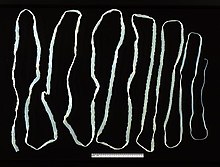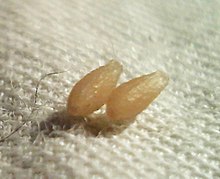Taenia (tapeworm)
| Taenia | |
|---|---|

| |
| Taenia saginata | |
| Scientific classification | |
| Domain: | Eukaryota |
| Kingdom: | Animalia |
| Phylum: | Platyhelminthes |
| Class: | Cestoda |
| Order: | Cyclophyllidea |
| Family: | Taeniidae |
| Genus: | Taenia Linnaeus, 1758 |
| Type species | |
| Taenia solium | |
Taenia is the type
The proglottids have a central
Selected species
- as intermediate hosts.
- Taenia bubesei was known to infect both the African lion, two Caspian tigers in southwestern Tajikistan harbored a few tapeworms in their small and large intestines, and they had been recovered earlier from the African lion, according to Chernyshev (1953).[2]
- Taenia crassiceps usually infects canines and also rodents, but rarely infect humans.
- Taenia gonyamai is parasite of antelope (as larvae) and lions (as adults).[3]
- swine as intermediate hosts to infect mainly dogs.
- Taenia mustelae infects small carnivorans.
- .
- wild dogs and in rabbits, which serve as intermediate hosts.
- Taenia rileyi infects bobcats.
- Taenia saginata, beef tapeworm, infects cattle and humans, and can only reproduce while in the human gut.
- Taenia solium, pork tapeworm, like T. saginata, has humans serving as its primary host, and it can only reproduce by the dispersal of proglottids while in the gut. These reinfect pigs when human faeces are improperly disposed of. This infection is most common in parts of Africa.
- Taenia taeniaeformis uses rodents as intermediate hosts and then inhabits cats as the definitive hosts.
- Taenia serialis is a parasite of dogs and foxes which has rabbits as the intermediate host.
Life cycle


- The hexacanth embryos) being passed in the feces, which can last for days to months in the environment. Sometimes, these segments will still be motile upon excretion—they either empty themselves of their eggs within a matter of minutes, or in some species, retain them as a cluster and await the arrival of a suitable intermediate vertebrate host.
- The intermediate host (cattle, pigs, rodents, etc., depending on the species) must then ingest the eggs or proglottids.
- If the host is a correct one for the particular species, then the embryophores will hatch, and the hexacanth embryos will invade the wall of the cysticercilarvae.
- Here they grow, cavitate, and differentiate into the second larval form shaped like a bladder (and erroneously believed until the middle of the 19th century to be a separate parasite, the bladderworm) which is infectious to the definitive host when an invaginated protoscolexis completely developed.
- To continue the process, the definitive host must eat the uncooked meat of the intermediate host. Once in the small intestine of the definitive host, the bladder is digested away, the scolex embeds itself into the intestinal wall, and the neck begins to bud off segments to form the strobila. New eggs usually appear in the feces of the definitive host within 6 to 9 weeks, and the cycle repeats itself.
T. saginata is about 1,000–2,000 proglottids long with each gravid proglottid containing 100,000 eggs, while T. solium contains about 1,000 proglottids with each gravid proglottid containing 60,000 eggs.[4]
Divergence of Taenia in humans
Humans were previously thought to have acquired Taenia species (T. solium, T. asiatica, and T. saginata) after the domestication of large mammals, although the omnivorous diet and foraging of early hominids suggest the contact between the ancestral Taenia was established prior to the rise of modern humans and advanced agriculture. Evidence suggests the domestication of animals by humans consequently introduced Taenia species to new intermediate hosts, cattle, and swine.[5]
Morphological and molecular data suggest that the divergence of Taenia specialised human parasites has been directly associated with earlier hominids and prior to the existence of modern Homo sapiens. Direct predator-prey relationships between humans and the original definitive and intermediate hosts of Taenia resulted in this
Host switching for Taenia is most prevalent among carnivores and less prevalent among herbivores through cospeciation. An excess of 50–60% of Taenia colonization occurs among carnivores—hyaenids, felids, and hominids.[6] Acquisition of the parasite occurs more frequently among definitive hosts than among intermediate hosts.[6] Therefore, host switching likely could not have come from cattle and pigs. The establishment of cattle and pigs as intermediate host by Taenia species is consequently due to the synanthropic relationship with humans. During the past 8,000–10,000 years, the colonization of respective Taenia species from humans to cattle and to swine was established.[6] In contrast, the colonization of ancestral Taenia onto the early hominids was established 1.0–2.5 million years ago.[6] It clearly shows that the colonization of human Taenia antedates the domestication of mammals.
References
- ^ Roberts, L.S. and Janovy, John Jr. Foundations of Parasitology 7th Edition. McGraw-Hill. 2005.
- ^ Heptner, V. G.; Sludskij, A. A. (1992) [1972]. Mlekopitajuščie Sovetskogo Soiuza. Moskva: Vysšaia Škola [Mammals of the Soviet Union. Volume II, Part 2. Carnivora (Hyaenas and Cats)]. Washington DC: Smithsonian Institution and the National Science Foundation. pp. 1–732.
- ^ Sachs, R (1969). "Untersuchungen zur Artbestimmung und Differenzierung der Muskelfinnen ostafrikanischer Wildtiere". Zeitschrift für Tropenmedizin und Parasitologie (in German). 20 (1): 39–50.
- ^ "Taeniasis". DPDx - Laboratory Identification of Parasitic Diseases of Public Health Concern. 29 November 2013. Retrieved 11 March 2016.
- ^ PMID 11345321.
- ^ PMID 16371252.
